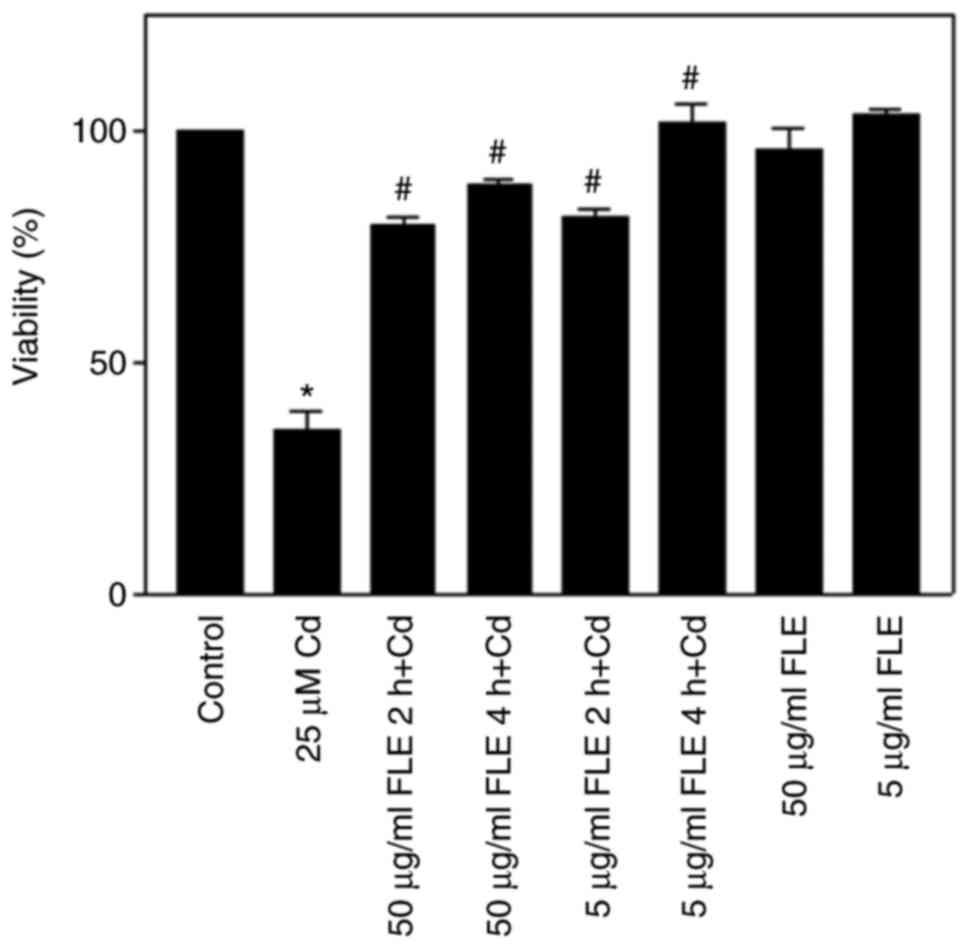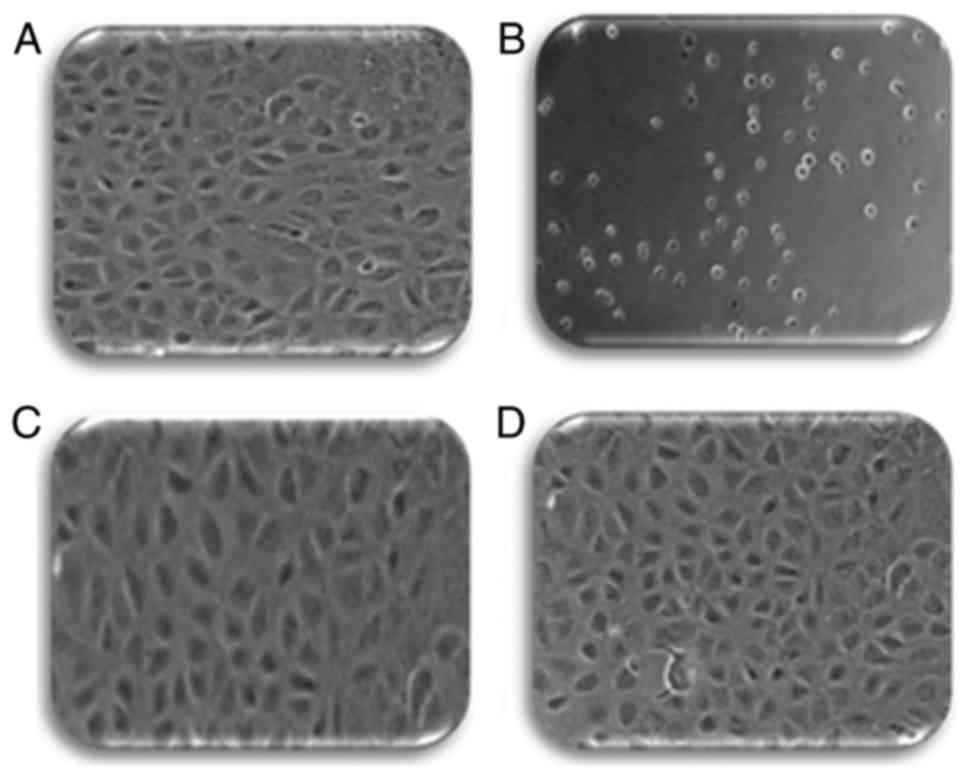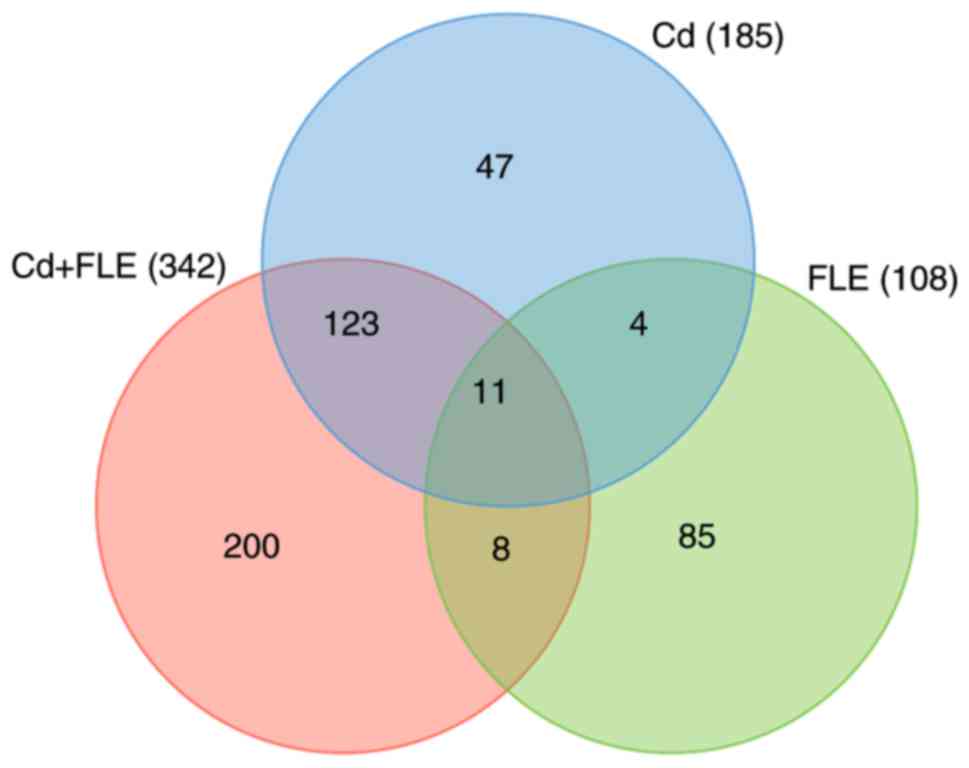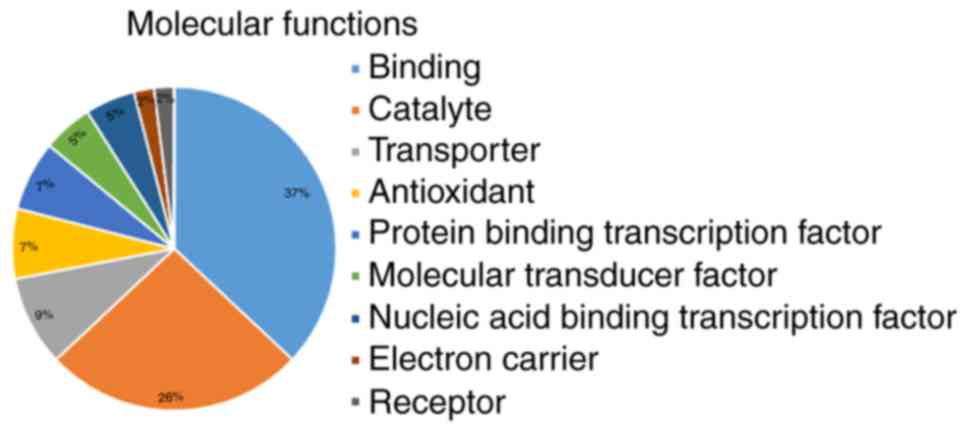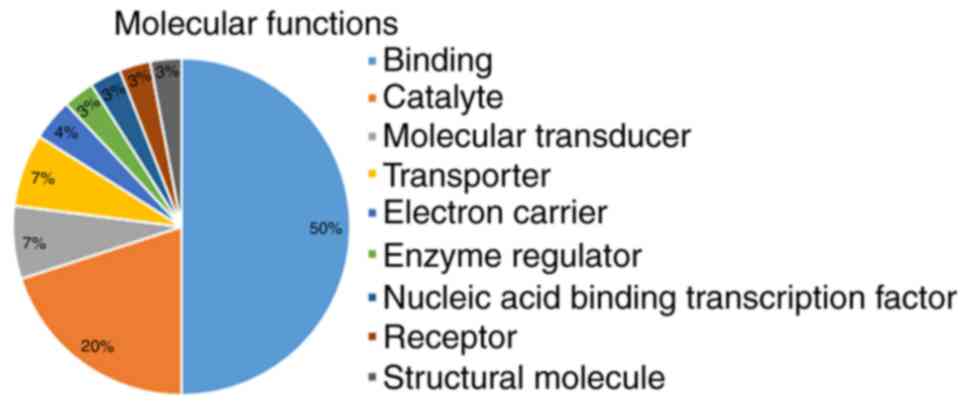|
1
|
Engström A, Michaëlsson K, Suwazono Y,
Wolk A, Vahter M and Akesson A: Long-term cadmium exposure and the
association with bone mineral density and fractures in a
population-based study among women. J Bone Miner Res. 26:486–495.
2011. View
Article : Google Scholar
|
|
2
|
Satarug S, Garrett SH, Sens MN and Sens
DA: Cadmium, environmental exposure, and health outcomes. Environ
Health Perspect. 118:182–190. 2010. View Article : Google Scholar : PubMed/NCBI
|
|
3
|
Järup L and Akesson A: Current status of
cadmium as an environmental health problem. Toxicol Appl Pharmacol.
238:201–208. 2009. View Article : Google Scholar : PubMed/NCBI
|
|
4
|
Anetor JI: Rising environmental cadmium
levels in developing countries: Threat to genome stability and
health. Niger J Physiol Sci. 27:103–115. 2012.PubMed/NCBI
|
|
5
|
Nasreddine L and Parent-Massin D: Food
contamination by metals and pesticides in the European Union.
Should we worry. Toxicol Lett. 127:29–41. 2002. View Article : Google Scholar : PubMed/NCBI
|
|
6
|
Agency for Toxic Substances and Disease
Registry (ATSDR): Toxicological Profile for Cadmium. Atlanta, GA:
U.S. Department of Health and Human Services, Public Health
Service; pp. 1–512. 2012
|
|
7
|
International agency for research on
cancer (IARC): Monographs on the Evaluation of the Carcinogenic
Risks to Humans, Beryllium, Cadmium, Mercury and Exposures in the
Glass Manufacturing industry. IARC Scientific Publications; Lyon,
France: pp. 119–238. 1993
|
|
8
|
El-Refaiy AI and Eissa FI: Histopathology
and cytotoxicity as biomarkers in treated rats with cadmium and
some therapeutic agents. Saudi J Biol Sci. 20:265–280. 2013.
View Article : Google Scholar : PubMed/NCBI
|
|
9
|
Lakshmi GD, Kumar PR, Bharavi K, Annapurna
P, Rajendar B, Patel PT, Kumar CS and Rao GS: Protective effect of
Tribulus terrestris linn on liver and kidney in cadmium intoxicated
rats. Indian J Exp Biol. 50:141–146. 2012.PubMed/NCBI
|
|
10
|
Thompson J and Bannigan J: Cadmium: Toxic
effects on the reproductive system and the embryo. Reprod Toxicol.
25:304–315. 2008. View Article : Google Scholar : PubMed/NCBI
|
|
11
|
Ikediobi CO, Badisa VL, Ayuk-Takem LT,
Latinwo LM and West J: Response of antioxidant enzymes and redox
metabolites to cadmium-induced oxidative stress in CRL-1439 normal
rat liver cells. Int J Mol Med. 14:87–92. 2004.PubMed/NCBI
|
|
12
|
Badisa VL, Latinwo LM, Odewumi CO,
Ikediobi CO, Badisa RB, Brooks-Walter A, Lambert AT and Nwoga J:
Cytotoxicity and stress gene microarray analysis in cadmium-exposed
CRL-1439 normal rat liver cells. Int J Mol Med. 22:213–219.
2008.PubMed/NCBI
|
|
13
|
Kaviarasan S and Anuradha CV: Fenugreek
(Trigonella foenum-graecum) seed polyphenols protect liver from
alcohol toxicity: A role on hepatic detoxification system and
apoptosis. Pharmazie. 62:299–304. 2007.PubMed/NCBI
|
|
14
|
Kaviarasan S, Viswanathan P and Anuradha
CV: Fenugreek seed (Trigonella foenum-graecum) polyphenols inhibit
ethanol-induced collagen and lipid accumulation in rat liver. Cell
Biol Toxicol. 23:373–383. 2007. View Article : Google Scholar : PubMed/NCBI
|
|
15
|
Sharma RD: Effect of fenugreek seeds and
leaves on blood glucose and serum insulin responses in human
subjects. Nutrition Res. 6:1353–1364. 1986. View Article : Google Scholar
|
|
16
|
Basch E, Ulbricht C, Kuo G, Szapary P and
Smith M: Therapeutic applications of fenugreek. Altern Med Rev.
8:20–27. 2003.PubMed/NCBI
|
|
17
|
Xue WL, Li XS, Zhang J, Liu YH, Wang ZL
and Zhang RJ: Effect of Trigonella foenum-graecum (fenugreek)
extract on blood glucose, blood lipid and hemorheological
properties in streptozotocin-induced diabetic rats. Asia Pac J Clin
Nutr. 16(Suppl 1): S422–S426. 2007.
|
|
18
|
Sharma RD, Raghuram TC and Rao NS: Effect
of fenugreek seeds on blood glucose and serum lipids in type I
diabetes. Eur J Clin Nutr. 44:301–306. 1990.PubMed/NCBI
|
|
19
|
Gupta A, Gupta R and Lal B: Effect of
Trigonella foenum-graecum (fenugreek) seeds on glycaemic control
and insulin resistance in type 2 diabetes mellitus: A double blind
placebo controlled study. J Assoc Physicians India. 49:1057–1061.
2001.
|
|
20
|
Ravikumar P and Anuradha CV: Effect of
fenugreek seeds on blood lipid peroxidation and antioxidants in
diabetic rats. Phytother Res. 13:197–201. 1999. View Article : Google Scholar : PubMed/NCBI
|
|
21
|
Amin A, Alkaabi A, Al-Falasi S and Daoud
SA: Chemopreventive activities of Trigonella foenum graecum
(Fenugreek) against breast cancer. Cell Biol Int. 29:687–694. 2005.
View Article : Google Scholar : PubMed/NCBI
|
|
22
|
Raju J, Patlolla JM, Swamy MV and Rao CV:
Diosgenin, a steroid saponin of Trigonella foenum graecum
(Fenugreek), inhibits azoxymethane-induced aberrant crypt foci
formation in F344 rats and induces apoptosis in HT-29 human colon
cancer cells. Cancer Epidemiol Biomarkers Prev. 13:1392–1398.
2004.PubMed/NCBI
|
|
23
|
Meera R, Devi P, Kameswari B, Madhumitha B
and Merlin NJ: Antioxidant and hepatoprotective activities of
Ocimum basilicum Linn. and Trigonella foenum-graecum Linn. against
H2O2 and CCL4 induced hepatotoxicity in goat
liver. Indian J Exp Biol. 47:584–590. 2009.PubMed/NCBI
|
|
24
|
Bajpai M, Mishra A and Prakash D:
Antioxidant and free radical scavenging activities of some leafy
vegetables. Int J Food Sci Nutr. 56:473–481. 2005. View Article : Google Scholar
|
|
25
|
Badisa RB, Tzakou O, Couladis M and
Pilarinou E: Cytotoxic activities of some Greek Labiatae herbs.
Phytother Res. 17:472–476. 2003. View Article : Google Scholar : PubMed/NCBI
|
|
26
|
Forrester LW, Latinwo LM, Fasanya-Odewumi
C, Ikediobi C, Abazinge MD, Mbuya O and Nwoga J: Comparative
studies of cadmium-induced single strand breaks in female and male
rats and the ameliorative effect of selenium. Int J Mol Med.
6:449–452. 2000.PubMed/NCBI
|
|
27
|
Odewumi CO, Badisa VL, Le UT, Latinwo LM,
Ikediobi CO, Badisa RB and Darling-Reed SF: Protective effects of
N-acetylcysteine against cadmium-induced damage in cultured rat
normal liver cells. Int J Mol Med. 27:243–248. 2011. View Article : Google Scholar
|
|
28
|
Odewumi CO, Buggs R, Badisa VL, Latinwo
LM, Badisa RB, Ikediobi CO, Darling-Reed SF and Owens MA:
Mitigative action of monoisoamyl-2,3-dimercaptosuccinate (MiADMS)
against cadmium-induced damage in cultured rat normal liver cells.
Toxicol In Vitro. 25:1733–1739. 2011. View Article : Google Scholar : PubMed/NCBI
|
|
29
|
Jonah MM and Bhattacharyya MH: Early
changes in the tissue distribution of cadmium after oral but not
intravenous cadmium exposure. Toxicology. 58:325–338. 1989.
View Article : Google Scholar : PubMed/NCBI
|
|
30
|
Solaiman D, Jonah MM, Miyazaki W, Ho G and
Bhattacharyya MH: Increased metallothionein in mouse liver,
kidneys, and duodenum during lactation. Toxicol Sci. 60:184–192.
2001. View Article : Google Scholar : PubMed/NCBI
|
|
31
|
Flora SJ, Mittal M and Mehta A: Heavy
metal induced oxidative stress and its possible reversal by
chelation therapy. Indian J Med Res. 128:501–523. 2008.PubMed/NCBI
|
|
32
|
Duracková Z: Some current insights into
oxidative stress. Physiol Res. 59:459–469. 2010.
|
|
33
|
Tanikawa K and Torimura T: Studies on
oxidative stress in liver diseases: Important future trends in
liver research. Med Mol Morphol. 39:22–27. 2006. View Article : Google Scholar : PubMed/NCBI
|
|
34
|
Vera-Ramirez L, Pérez-Lopez P,
Varela-Lopez A, Ramirez-Tortosa M, Battino M and Quiles JL:
Curcumin and liver disease. Biofactors. 39:88–100. 2013. View Article : Google Scholar : PubMed/NCBI
|
|
35
|
Zafeer MF, Waseem M, Chaudhary S and
Parvez S: Cadmium-induced hepatotoxicity and its abrogation by
thymoquinone. J Biochem Mol Toxicol. 26:199–205. 2012. View Article : Google Scholar : PubMed/NCBI
|
|
36
|
Amamou F, Nemmiche S, Meziane RK, Didi A,
Yazit SM and Chabane-Sari D: Protective effect of olive oil and
colocynth oil against cadmium-induced oxidative stress in the liver
of Wistar rats. Food Chem Toxicol. 78:177–184. 2015. View Article : Google Scholar : PubMed/NCBI
|
|
37
|
Jain SC and Madhu A: Regulation of
trigonellin in Trigonella species by chemical mutagenic treatments.
Indian Drugs. 26:14–16. 1988.
|
|
38
|
Kamal R and Yadav R: Flavonoids from
Trigonella polycerta in-vivo and in-vitro. J Phytological Res.
4:161–165. 1991.
|
|
39
|
Swain AR, Dutton SP and Truswell AS:
Salicylates in foods. J Am Diet Assoc. 85:950–960. 1985.PubMed/NCBI
|
|
40
|
Liu Y, Kakani R and Nair MG: Compounds in
functional food fenugreek spice exhibit anti-inflammatory and
antioxidant activities. Food Chemistry. 131:1187–1192. 2012.
View Article : Google Scholar
|
|
41
|
Ahmadiani A, Javan M, Semnanian S, Barat E
and Kamalinejad M: Anti-inflammatory and antipyretic effects of
Trigonella foenum-graecum leaves extract in the rat. J
Ethnopharmacol. 75:283–286. 2001. View Article : Google Scholar : PubMed/NCBI
|
|
42
|
McNamara MJ, Kasiewicz MJ, Linch SN, Dubay
C and Redmond WL: Common gamma chain (γc) cytokines differentially
potentiate TNFR family signaling in antigen-activated CD8(+) T
cells. J Immunother Cancer. 2:282014.
|
|
43
|
Grönroos E, Terentiev AA, Punga T and
Ericsson J: YY1 inhibits the activation of the p53 tumor suppressor
in response to genotoxic stress. Proc Natl Acad Sci USA.
101:12165–12170. 2004. View Article : Google Scholar : PubMed/NCBI
|
|
44
|
Glahn F, Schmidt-Heck W, Zellmer S, Guthke
R, Wiese J, Golka K, Hergenröder R, Degen GH, Lehmann T, Hermes M,
et al: Cadmium, cobalt and lead cause stress response, cell cycle
deregulation and increased steroid as well as xenobiotic metabolism
in primary normal human bronchial epithelial cells which is
coordinated by at least nine transcription factors. Arch Toxicol.
82:513–524. 2008. View Article : Google Scholar : PubMed/NCBI
|
|
45
|
Chen W, Zhang Z, Dong H and Jiang X:
Molecular cloning and sequence analysis of selenoprotein W gene and
its mRNA expression patterns in response to metabolic status and
cadmium exposure in goldfish, Carassius auratus. Comp Biochem
Physiol B Biochem Mol Biol. 184:1–9. 2015. View Article : Google Scholar : PubMed/NCBI
|
|
46
|
Huang C, Zhang Q, Li J, Shi X, Castranova
V, Ju G, Costa M and Dong Z: Involvement of Erks activation in
cadmium-induced AP-1 transactivation in vitro and in vivo. Mol Cell
Biochem. 222:141–147. 2001. View Article : Google Scholar : PubMed/NCBI
|
|
47
|
Mita P, Savas JN, Ha S, Djouder N, Yates
JR III and Logan SK: Analysis of UR1 nuclear interaction with RPB5
and components of the R2TP/prefoldin-like complex. PLoS One.
8:e638792013. View Article : Google Scholar
|
|
48
|
Yang Z, Yang S, Qian SY, Hong JS, Kadiiska
MB, Tennant RW, Waalkes MP and Liu J: Cadmium-induced toxicity in
rat primary mid-brain neuroglia cultures: Role of oxidative stress
from microglia. Toxicol Sci. 98:488–494. 2007. View Article : Google Scholar : PubMed/NCBI
|
|
49
|
Asagba SO: Alteration in the activity of
oxidative enzymes in the tissues of male Wistar albino rats exposed
to cadmium. Int J Occup Med Environ Health. 23:55–62. 2010.
View Article : Google Scholar : PubMed/NCBI
|
|
50
|
Fabbri M, Urani C, Sacco MG, Procaccianti
C and Gribaldo L: Whole genome analysis and microRNAs regulation in
HepG2 cells exposed to cadmium. ALTEX. 29:173–182. 2012. View Article : Google Scholar : PubMed/NCBI
|
|
51
|
Ola-Mudathir FK and Suru SM: Onion and
garlic extracts as potential antidotes for cadmium-induced
biochemical alterations in prostate glands of rats. Andrologia.
47:1075–1082. 2014. View Article : Google Scholar : PubMed/NCBI
|















